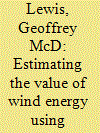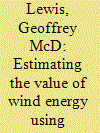|
|
|
Sort Order |
|
|
|
Items / Page
|
|
|
|
|
|
|
| Srl | Item |
| 1 |
ID:
096624


|
|
|
|
|
| Publication |
2010.
|
| Summary/Abstract |
There is an increasing interest in adding renewables such as wind to electricity generation portfolios in larger amounts as one response to concern about atmospheric carbon emissions from our energy system and the resulting climate change. Most policies with the aim of promoting renewables (e.g., RPS, FIT) do not explicitly address siting issues, which for wind energy are currently approached as the intersection of wind resource, land control, and transmission factors. This work proposes the use of locational marginal price (LMP), the location and time specific cost of electricity on the wholesale market, to signal locations where generation can address electricity system insufficiency. After an examination of the spatial and temporal behavior of LMP in Michigan over the first two years of wholesale market operation, this work combines LMP with wind speed data to generate a value metric. High value sites in Michigan tend to be sites with higher wind speeds, with the bulk of value accruing in the fall and winter seasons.
|
|
|
|
|
|
|
|
|
|
|
|
|
|
|
|
| 2 |
ID:
097464


|
|
|
|
|
| Publication |
2010.
|
| Summary/Abstract |
There is an increasing interest in adding renewables such as wind to electricity generation portfolios in larger amounts as one response to concern about atmospheric carbon emissions from our energy system and the resulting climate change. Most policies with the aim of promoting renewables (e.g., RPS, FIT) do not explicitly address siting issues, which for wind energy are currently approached as the intersection of wind resource, land control, and transmission factors. This work proposes the use of locational marginal price (LMP), the location and time specific cost of electricity on the wholesale market, to signal locations where generation can address electricity system insufficiency. After an examination of the spatial and temporal behavior of LMP in Michigan over the first two years of wholesale market operation, this work combines LMP with wind speed data to generate a value metric. High value sites in Michigan tend to be sites with higher wind speeds, with the bulk of value accruing in the fall and winter seasons.
|
|
|
|
|
|
|
|
|
|
|
|
|
|
|
|
| 3 |
ID:
098646


|
|
|
|
|
| Publication |
2010.
|
| Summary/Abstract |
Green electricity generation can provide an indirect route to cleaner air: by displacing generation from fossil fuels, green electricity can reduce emissions of CO2 and conventional air pollutants. Several types of voluntary markets have emerged in the United States to take advantage of this relationship, including green electricity programs, carbon offsets, and renewable energy certificates. At the same time, regulators are favoring cap-and-trade mechanisms for regulating emissions. This paper describes the appropriate framing of environmental claims for green electricity products. We apply an accounting framework for evaluating claims made for capped pollutants, with entries for emissions, avoided emissions due to green electricity, and unused emission permits. This framework is applied in case studies of two major electric utilities that operate with green electricity programs and capped pollutants. The cases demonstrate that the relative magnitude of "unused permits" and "emissions avoided" is a key relationship for evaluating an emissions reduction claim. Lastly, we consider the evolution of the green electricity marketplace given the reliance on cap-and-trade. In this setting, pollution-emission products could be decoupled from one another and from the various green electricity products. Several positive consequences could transpire, including better transparency of products, lower certification costs, and more product choices.
|
|
|
|
|
|
|
|
|
|
|
|
|
|
|
|
|
|
|
|
|